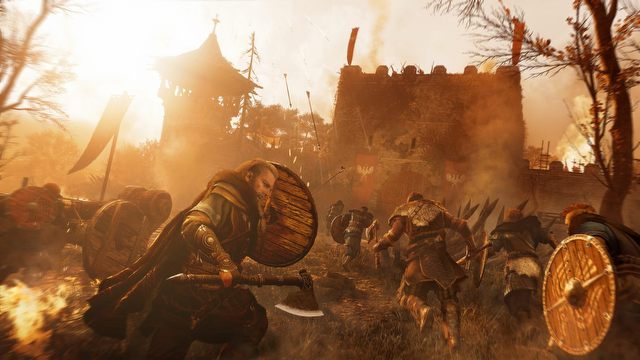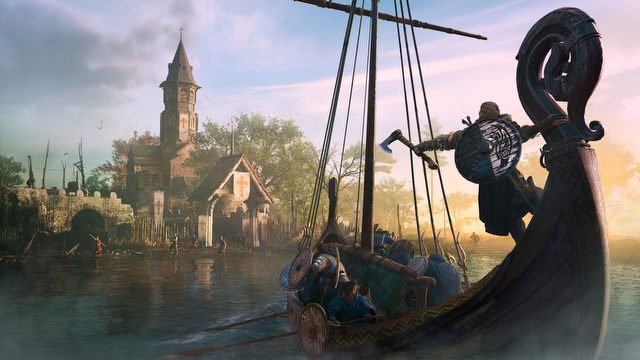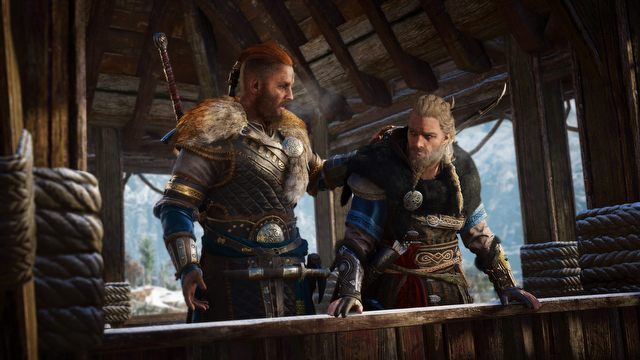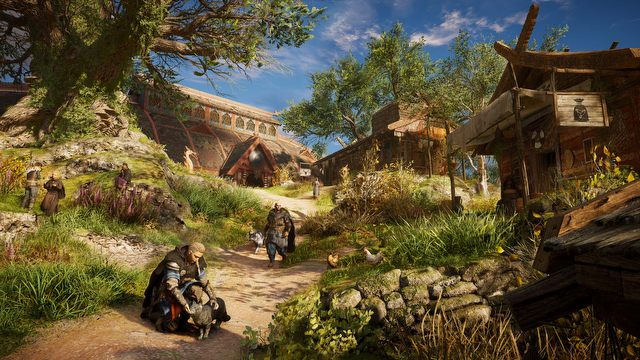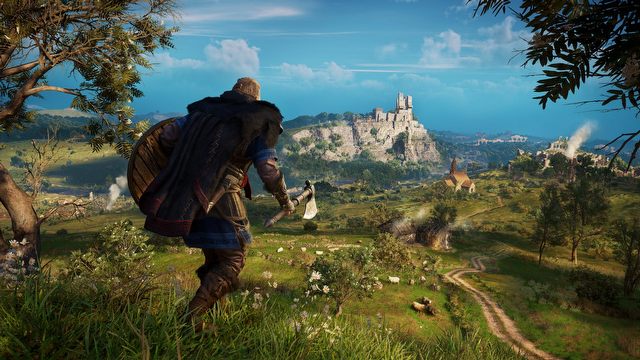I played AC Valhalla – Chasing Kratos from Greece to the North
Ubisoft gave the creators of Assassin's Creed Valhalla an extra year to work on the game. Has this given us more than an extended Odyssey? After three hours of playing, we know the answer to that question.
When Ubisoft broke the tradition of regularly releasing games from the Assassin's Creed series every year we received Origins – a revolutionary product for the series. A large group of fans assumed that Valhalla would also undergo the same process of "maturing" and be something new and fresh, so let's start by saying what has to be said. The new installment of the Assassin saga is a game very similar to its predecessor, and even the various improvements in the formula do not change the fact that it is only an expansion of ideas introduced in Origins and later expanded in Odyssey, not something new at all. All those disappointed with such a turn of events are left to swallow this bitter pill, and the rest of us who remember Alexios and Cassandra very well should be pleased.
Ubisoft allowed us to play Valhalla for more than three hours. Despite the limited time, we were able to complete several tasks in peace (both from the main and side ones), check out various additional activities, murder at least a dozen opponents, and visit the world available in the showcased version, which - traditionally for the French company - is a sight to explore. What were we unable to do? First of all, we haven't been able to move into a Viking Village and see what its development looks like. This supposedly quite an important aspect of the game was completely omitted from the demo. It is a shame because we would like to see what the developers have prepared in this regard.
From Northumbria to Wessex
All right, now that the most important thing is behind us, we can take a closer look at Valhalla. The first thing thrown at us was the giant map of England, which stretches from Northumbria in the north to the borders of the Kingdom of Wessex in the south-west. Although it is in fact an area similar in size to the Hellada known from Odyssey (speaking only of the mainland), it does not refer to the world being smaller, quite the opposite. Suffice it to say that the relatively small region of East Anglia where the demos took place is more than two kilometers wide (in units given by the game). By comparison, the entire map in Odyssey was sixteen kilometers wide, and let us remember that in the predecessor we still had open waters, explored by ship. Given the fact that while we are on the British islands, we are mainly up for traveling on land. We will also be able to return to Norway, which will offer a lot to explore.
The map draws attention to itself for one more reason - it is extremely clear. For the first time in history, the authors opted for a drawn sheet that resembled the real works of cartographers and minimized the icons characteristic for the series. Instead, we see dots in different colors that inform us that there is something interesting in a particular place. Their color defines a type of activity as they have been divided into three groups (riches, mysteries, and secrets), which in turn will influence our control of the region in some way. Traditional icons only point to the most important places, namely shops, observation towers, and NPCs who will give you some tasks.
In terms of additional activities, they are very diverse. We will come to liberate villages from thugs and steal the valuables hidden in houses, destroy the cursed objects that surround the area with a strange fog, fight the bosses of the whole region, and spend time on mini-games. The latter include stacking stone mounds, which can often be found on Norwegian tourist routes, or stacking glyphs based on the pattern given in a given location. These symbols can only be seen after enabling the eagle's eye, which Eivor, of course, possesses (in the game he is called Odin Sight). Fishing enthusiasts will surely be pleased to learn that in Valhalla you can also spend some time on fishing.
SOUNDTRACK OD THE DECADE
Players who follow Assassin's Creed: Valhalla will surely know by now that Sarah Schachner and Jesper Kyd are responsible for the soundtrack in this production. They are accompanied by Einar Selvik from Wardruna, which was heavily popularized by the Vikings series. Let me be brief – we're about to have the soundtrack of a decade, and perhaps the best music album in the history of the entire Assassin's Creed series. What these artists have done in the sound layer is absolutely top-quality and even if I had never played ACV, I would certainly have reached for the soundtrack. For fans of the Norse vibe, this will be an absolute must-have.
On foot, on horseback and on a long Viking boat
Players can travel both on foot and on horseback, Eivor has also been given a langskip, which – and there is a big change here – does not have the same function as Edward Kenway's ship or Cassandra's/Alexios' Adrestia. The ship is primarily used to transport troops and there is no indication that it could be used to attack other ships. You can steer the boat yourself or hand it over to artificial intelligence that obediently takes us to a predetermined place on the map. Let us add that during the cruise you can listen to the Viking equivalent of chanteys, i.e. various sea songs native to the far north. As you can see, certain elements just need to be implemented in Ubisoft's games.
The feature missions available in the demo – to put it mildly – did not particularly knock our socks off, and apart from two of them, which I will write about in a moment, they did not fall into my memory at all. The authors specifically selected this part of the game to showcase the infamous raids featuring the possibility of an alternative attack on an enemy outpost using the warriors available on the ship. Interestingly, the first time I decided to attack a hostile camp on my own, and I almost succeeded. No doubt the experience of the previous series, where many forts could be cleared quietly without much trouble, hiding in the grass and eliminating other rivals, helped here. It was definitely harder here, so in the end, I had to reach for the axe anyway, but I admit that being able to choose how to attack is positive in the context of this game because it provides a refreshing alternative if you're getting tired of one of the methods.
In Assassin's Creed: Valhalla, you can play both as a man and a woman, but the gender choice will not be final, as in Odyssey. This time, the decision made at the start can be changed at any point in the game using a dedicated menu option. It is fair to say that this solution is quite brave, especially in the context of the canonicity of the hero. The authors had previously announced that they had come up with an original idea of how to deal with this problem (Cassandra was canonical in Odyssey) and apparently this is their brilliant solution.
Stronghold: Viking
The most memorable plot mission in the demo turned out to be an attack on an enemy castle from water, where the langskip expedition was mandatory. When approaching the enemy fortifications it was necessary to protect against a rain of fire arrows, and upon landing, there was a bloodbath, compounded by the need to break down further gates with a battering ram. The important information is the fact that we are able to help break down these gates because Eivor can and should in principle assist the companions in breaking through enemy fortifications. Before that, though, it's worth looking at running opponents who don't intend to make the raiders' job any easier.
Here, our hero had to act mostly alone, as none of his teammates struggled to climb higher and only dealt with his opponents at the bottom. So we had a typical Odyssey slaughter here, and the main difference was that now tired opponents can be finished off with impressive and generally quite brutal finishers. The order is given when a corresponding icon appears above a virtual rival. The entire combat sequence culminated in a boss battle, who was aided by a wolf and had... a flaming sword. If anyone was deluding themselves that Valhalla would be a game more down-to-earth than Odyssey, well, they were wrong.
I remembered the second mission for completely different reasons. The protagonist took part in the wedding of a local warlord, and the whole in some ways resembled a memorable wedding in Bronowice from the Hearts of Stone DLC to The Witcher 3 – not so funny, but still... Like Geralt, Eivor was also able to take part in several side activities at the event, including pot shooting and a drinking contest where you had to drink with a rival in a simple mini-game. Meanwhile, there was also quick sex between the hero and one of his raid colleagues. Interestingly, the game did not warn us about the possibility of going to bed when choosing a dialogue line – the familiar icon from its predecessor, indicating the consequences of a dialogue line was removed irrevocably.
No changes
Everything else is basically a copy of the last two installments of the series, only slightly modified. As a "novelty" we can certainly replace first aid kits that can be used during combat. We get them by collecting herbs growing here and there, so you can be sure that picking flowers will become a must-do activity in Valhalla. Special skills useful in combat work in the same way, so we still have to fill adrenaline bars to activate them. When it comes to the repertoire of actions available this way, it's still colorful and fun. Eivor, for example, can shoot as many as five arrows from a bow after tracking enough opponents. When there is only one opponent, in that case, we only shoot him, obviously increasing the damage. It turns out to be quite effective when fighting bosses.
The clashes themselves have not been revolutionised in any way. You still have to use the rebound to avoid getting caught by an opponent's punch or a flip when an attack is coming in our direction that you can't block. In other cases, it is possible to punch without thinking about what we want there, also using two axes or two shields. There are finishers mentioned earlier, which paradoxically are not only spectacular but also most useful because after firing the animation no one will be able to hit us. The authors say the combat model is still being tweaked, but we don't think there will be any radical changes to it. Whoever played Odyssey will feel at home because the melee hammering is essentially the same.
And that's basically all we can tell you about Assassin's Creed: Valhalla at the moment. You have to see for yourself how the horse works because, by the time you read this text, there are already various records of the game available online. Of course, they will not allow you to fully assess what the Viking version of the series will ultimately offer, but they will be enough to have a preliminary opinion of sorts. We particularly recommend taking a look at dialogues with the NPCs, because we think they are just as thrilling as Odyssey, which means "not thrilling." My assertion that "Assassin's Creed is currently an 18+ game written for 13-year-olds" is still valid.
Despite some drawbacks, which are now visible, I am looking forward to Valhalla. I'm not going to beat around the bush – the setting is perfectly tailored for me, I have a general fondness for Norse culture and I'm already rubbing my hands at the thought of the vibe that will be oozing from the screen. However, I do not delude myself that it will be a great step in the right direction after Odyssey that I disliked, because it is already clear that radical changes in the formula will not happen. Critical fans need to take this under consideration, while everyone else – as I mentioned earlier – should be delighted. Given the phenomenal sales of Cassandra and Alexios ' adventures in ancient Greece, the latter group will be favored, and from a commercial point of view, I'm not surprised at all. That's the times we're living in.
